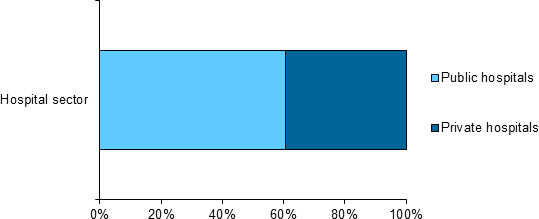How much activity was there for patients aged 85 years and over?
In 2014–15, people aged 85 and over (who make up 2% of the population) accounted for 7% (690,658) of all hospital separations (10,150,367). Sixty-one per cent (418,347) of these separations occurred in public hospitals and 39% (272,311) in private hospitals (Figure 1).
Figure 1: Proportion of separations for patients aged 85 years and over by hospital sector, 2014–15

Source: National Hospital Morbidity Database (NHMD).
Box 1: Understanding admitted patient care terms
This spotlight draws on data from the National Hospital Morbidity Database (NHMD). The NHMD is based on data provided to the Australian Institute of Health and Welfare (AIHW) by state and territory health authorities for the National Minimum Data Set (NMDS) for Admitted patient care. It contains episode-level records from admitted patient morbidity data collection systems in Australian public and private hospitals and include administrative, demographic and clinical data.
Admitted patient
An admitted patient is a patient who undergoes a hospital's formal admission process. Statistics on admitted patients are compiled when an admitted patient completes an episode of admitted patient care and 'separates' from the hospital. This is because most of the data on the use of hospitals by admitted patients are based on information provided at the end of the patients' episodes of care, rather than at the beginning. The length of stay and the procedures carried out are then known and the diagnostic information is more accurate.
Hospital separation
A hospital separation is the term used to refer to the episode of admitted patient care, which can be a total hospital stay (from admission to discharge, transfer or death) or a portion of a hospital stay beginning or ending in a change of type of care (for example, from acute care to rehabilitation). 'Separation' also means the process by which an admitted patient completes an episode of care by being discharged, dying, transferring to another hospital or changing type of care.
Same-day separation
A same-day separation occurs when a patient is admitted to and separated from the hospital on the same date.
Overnight separation
An overnight separation occurs when a patient is admitted to and separated from the hospital on different dates.
Length of stay
Length of stay is measured using 'patient days'. The length of stay for an overnight patient is calculated by subtracting the date the patient is admitted from the date of separation and deducting days the patient was on leave (for example, went home for part of a day with the intention of return). A same-day patient is allocated a length of stay of 1 day.
Care type
The care type describes the overall nature of a clinical service provided to an admitted patient during an episode of care. The care type can be classified as:
- Acute
- Newborn (not applicable for this spotlight)
- Sub-acute (Rehabilitation care, Palliative care, Geriatric evaluation and management, and Psychogeriatric care)
- Non-acute (Maintenance care)
- Other admitted patient care.


